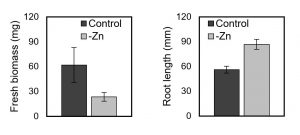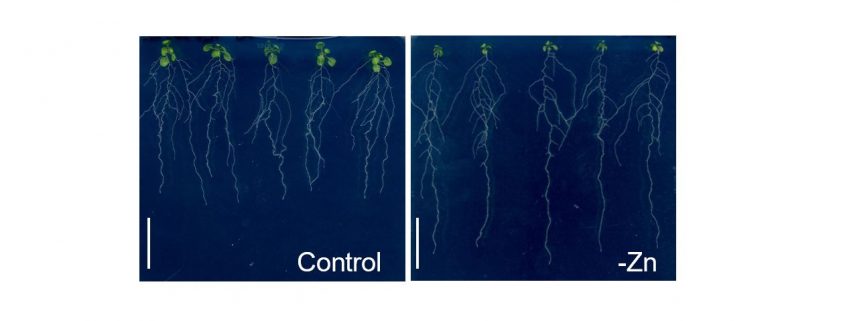Leaves Call to Roots: “Need More Zinc!”
Sinclair et al. show that a low Zn status of shoots triggers in roots the transcription of genes important in root-to-shoot translocation of Zn. The Plant Cell (2018). https://doi.org/10.1105/tpc.18.00207
By Scott A. Sinclair and Ute Krämer
Department of Molecular Genetics and Physiology of Plants, Ruhr University Bochum
Background: When Zn availability in the soil is limited, plant growth is compromised, and plants contain less Zn. This influences agricultural yields, as plants are smaller, and human health, as plants are the primary entry point for Zn in the food chain. The WHO estimates that more than 2 billion people have diets with inadequate levels of Zn. Understanding the physiological mechanisms used by plants to adapt to Zn-limited soils will allow the development of crops that maintain yields on low-Zn soils and contain more Zn to combat human Zn deficiency.
Question: We designed an experiment to disentangle the immediate, locally controlled Zn deficiency responses of the root from those controlled by signals from the shoot. We then explored how these shoot-controlled responses in roots influence plant growth in low-Zn conditions.

Arabidopsis plants have decreased fresh biomass, and increased primary root growth when Zn is limited
Findings: We used the model plant Arabidopsis thaliana, grown in both sterile conditions on agar plates and hydroponic culture, in standard (5 µM Zn) or Zn-deficient (0 µM Zn) media. We found that rates of transcription of the METAL TOLERANCE PROTEIN2 (MTP2) and HEAVY METAL ATPASE2 (HMA2) genes in roots increased with lowered Zn levels in the shoot and were not dependent on Zn levels in the root. Analysis of mtp2, hma2, and mtp2 hma2 mutants demonstrated that MTP2 and HMA2 contribute to root-to-shoot translocation of Zn when shoot Zn status is low. HMA2 transports Zn into the root xylem, where mass flow takes Zn to the shoot. We propose that MTP2 facilitates inward movement of Zn across the root from epidermis to xylem, by enhancing cell-to-cell movement of Zn through the desmotubules of plasmodesmata.
Next steps: Transcriptomic and metabolite analyses of phloem sap from control and Zn-deficient plants could be used to identify the mobile signal that activates HMA2 and MTP2 transcription in roots. It will also be important to elucidate how Zn deficiency is perceived in shoots, the signaling cascades that activate production of the mobile signal in shoots, and those that act in its perception in roots. Further steps include identification of transcription factors controlling the expression of MTP2 and HMA2.
Scott A. Sinclair, Toralf Senger, Ina N. Talke, Christopher S. Cobbett, Michael J. Haydon, and Ute Krämer. (2018). Systemic upregulation of MTP2- and HMA2-mediated Zn partitioning to the shoot supplements local Zn deficiency responses of Arabidopsis. Plant Cell 30: 2463-2479; DOI: https://doi.org/10.1105/tpc.18.00207
Key Words: Zn-deficiency; nutrition; signaling; adaptation




